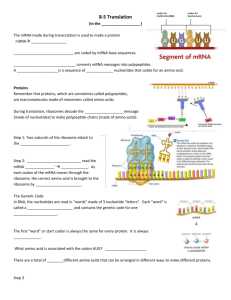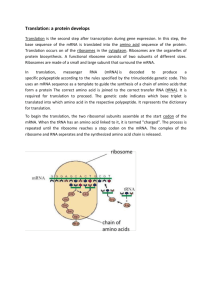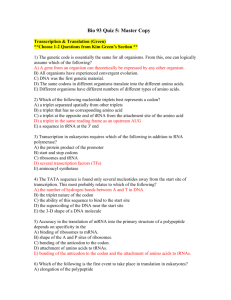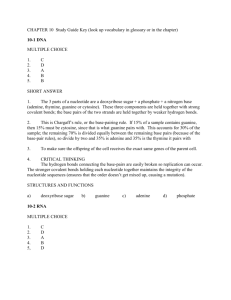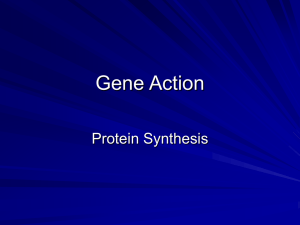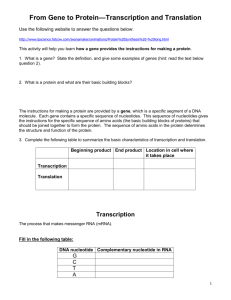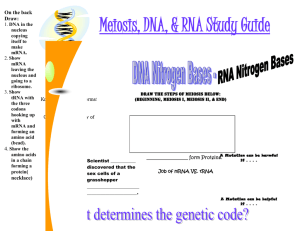From Gene to Protein*Transcription and Translation
advertisement
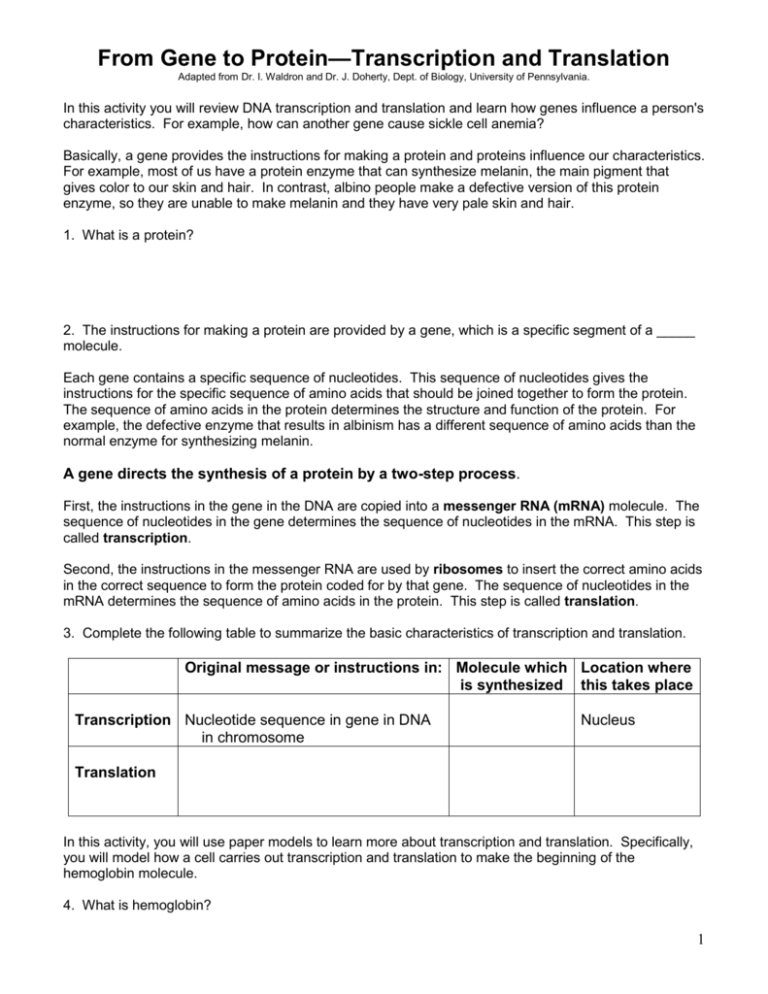
From Gene to Protein—Transcription and Translation Adapted from Dr. I. Waldron and Dr. J. Doherty, Dept. of Biology, University of Pennsylvania. In this activity you will review DNA transcription and translation and learn how genes influence a person's characteristics. For example, how can another gene cause sickle cell anemia? Basically, a gene provides the instructions for making a protein and proteins influence our characteristics. For example, most of us have a protein enzyme that can synthesize melanin, the main pigment that gives color to our skin and hair. In contrast, albino people make a defective version of this protein enzyme, so they are unable to make melanin and they have very pale skin and hair. 1. What is a protein? 2. The instructions for making a protein are provided by a gene, which is a specific segment of a _____ molecule. Each gene contains a specific sequence of nucleotides. This sequence of nucleotides gives the instructions for the specific sequence of amino acids that should be joined together to form the protein. The sequence of amino acids in the protein determines the structure and function of the protein. For example, the defective enzyme that results in albinism has a different sequence of amino acids than the normal enzyme for synthesizing melanin. A gene directs the synthesis of a protein by a two-step process. First, the instructions in the gene in the DNA are copied into a messenger RNA (mRNA) molecule. The sequence of nucleotides in the gene determines the sequence of nucleotides in the mRNA. This step is called transcription. Second, the instructions in the messenger RNA are used by ribosomes to insert the correct amino acids in the correct sequence to form the protein coded for by that gene. The sequence of nucleotides in the mRNA determines the sequence of amino acids in the protein. This step is called translation. 3. Complete the following table to summarize the basic characteristics of transcription and translation. Original message or instructions in: Molecule which Location where is synthesized this takes place Transcription Nucleotide sequence in gene in DNA in chromosome Nucleus Translation In this activity, you will use paper models to learn more about transcription and translation. Specifically, you will model how a cell carries out transcription and translation to make the beginning of the hemoglobin molecule. 4. What is hemoglobin? 1 Transcription Since transcription is the process that makes messenger RNA (mRNA), we need to begin by understanding a little about the structure of mRNA. mRNA is a single-stranded polymer of nucleotides, each of which contains a nitrogenous base, a sugar and a phosphate group, similar to the nucleotides that make up DNA. mRNA is a ribonucleic acid because each nucleotide in RNA includes the sugar ribose, whereas DNA is a deoxyribonucleic acid because each nucleotide in DNA has a different sugar, deoxyribose. Simplified Diagram of Beginning of mRNA Molecule nitrogenous nitrogenous nitrogenous base 1 base 2 base 3 | | | sugar — phosphate — sugar — phosphate — sugar — phosphate —... nucleotide 1 nucleotide 2 nucleotide 3 etc. How does the information in the DNA of the gene get copied into a message in the mRNA? When the mRNA is synthesized, RNA nucleotides are added one at a time, and each RNA nucleotide is matched to the corresponding DNA nucleotide in the gene. This nucleotide matching follows a base-pairing rule very similar to the base-pairing rule in the DNA double helix (see table). Complementary nucleotides for base-pairing between two strands of DNA Complementary nucleotides for base-pairing between DNA and RNA G (guanine) pairs with C (cytosine). G pairs with C. T (thymine) pairs with A (adenine). T in DNA pairs with A in RNA. A in DNA pairs with U (uracil) in RNA. This base-pairing rule ensures that the message from the nucleotide sequence in the gene in the DNA is copied into a corresponding nucleotide sequence in the mRNA molecule. The figure on the next page shows how the complementary RNA nucleotides are added one at a time to the growing mRNA molecule. 2 (Figure 17.7, Campbell and Reece, Biology, 2005) This figure shows that transcription requires an enzyme, RNA polymerase, which separates the two strands of DNA and adds RNA nucleotides, one at a time, to form the mRNA molecule. 1. Why is RNA polymerase a good name for this enzyme? Transcription Modeling Procedure Note: You will work with a partner to model the actual sequence of steps used by the cell to carry out transcription. You probably will be able to think of a faster way to make the mRNA, but you should follow the sequence of steps described below in order to learn how the cell actually makes mRNA. Remember, enzymes like RNA polymerase do not have a brain, eyes or hands, so transcription must proceed in a step-by-step chemical process that adds one nucleotide at a time to the growing mRNA molecule. 1. To model the process of transcription and translation, you and your partner will need a box containing: DNA Nucleotides (Purple) mRNA Nucleotides (Light Blue) tRNA Nucleotides (Yellow) Amino acids (Salmon) In addition, you should prepare by completing the following chart to summarize the base-pairing rule you will need to follow as you synthesize the mRNA molecule. Correctly spell out the nucleotides in full. DNA nucleotide Complementary nucleotide in RNA G C T A 3 2. First lay out the DNA molecule as shown below. Bold upper-case nucleotides on the top strand and hollow upper-case nucleotides on the bottom strand. Place the promoter sequence at the beginning of the sequence and terminator sequence at the end. Fill in the boxes below with what you would expect these sequences to be if you were RNA Polymerase TACCTCCAGTTAGATAGGGGCCCGATC 3. One of you will act as the RNA polymerase, and the other one will be the cytoplasm which surrounds the nucleus and supplies the nucleotides which are used to make the RNA molecule. As RNA Polymerase carefully separates the two strands of DNA the cytoplasm should pass the corresponding mRNA nucleotides to RNA Polymerase, who then places the mRNA into the complimentary position. Given synthesis of DNA and RNA always proceeds in a 5’->3’ direction label the above DNA sequence with 5’ and 3’ ends…….CAREFULL, think about it. 4. Repeat step 3 as often as needed to complete transcription of the beginning of the hemoglobin gene, adding one nucleotide at a time to the mRNA molecule. Be careful to follow the base-pairing rule accurately, so your mRNA will provide accurate information for synthesizing the beginning of the hemoglobin protein when you get to the translation step. Questions 1. Notice that the process of transcription is similar to the process of DNA replication. What are some similarities between transcription and DNA replication? 2. There are also a few important differences between DNA replication and transcription. Fill in the blanks in the following table to summarize these differences. DNA replication Transcription The whole chromosome is replicated. ___________________is transcribed. DNA is made. DNA is double-stranded. mRNA is made. mRNA is _____________ -stranded. DNA polymerase is the enzyme which carries out DNA replication. _____ polymerase is the enzyme which carries out transcription. T = thymine is used in DNA, so A pairs with T in DNA. T = thymine is replaced by ___ = uracil in RNA, so A in DNA pairs with ___ in mRNA. 4 3. To summarize what you have learned, explain how a gene directs the synthesis of an mRNA molecule. Include in your explanation the words and phrases: base-pairing rule, complementary nucleotides, cytoplasm, DNA, gene, messenger RNA, nucleotide, nucleus, and RNA polymerase. Translation In the process of translation, the sequence of nucleotides in messenger RNA (mRNA) determines the sequence of amino acids in a protein. The figure below shows an example of how transcription is followed by translation. (Figure 14.6 from Krogh, Biology, a Guide to the Natural World, 2005) In translation, each set of three nucleotides in an mRNA molecule codes for one amino acid in a protein. This explains why each set of three nucleotides in the mRNA is called a codon. Each codon specifies a particular amino acid. For example, the first codon shown above, CGU, instructs the ribosome to put the amino acid arg (arginine) as the first amino acid in this protein. The sequence of codons in the mRNA determines the sequence of amino acids in the protein. The table below shows the seven codons that will be part of your mRNA molecule, together with the amino acid coded for by each of these codons. AAU UCC GGC CCG CUA GAG GUC Asparagine (Asn) Serene (Ser) Glycine (Gly) Proline (Pro) Leucine (Leu) Glutamic acid (Glu) Valine (Val) 5 How does translation actually take place? Inside a cell, each tiny ribosome provides a workbench with the structure and enzyme needed for translation to take place. But how are the right amino acids added in the right sequence to match the sequence of codons in the mRNA? Translation is more complicated than transcription; the shape and chemical structure of each amino acid does not match the shape and chemical structure of the corresponding mRNA codon. Instead, a special type of RNA, transfer RNA (tRNA), is required to ensure that the correct amino acid is brought in to match each codon in the mRNA. (Figure 14.7 from Krogh, Biology, a Guide to the Natural World, 2005) There are multiple different types of tRNA. Each type of tRNA molecule has three nucleotides that form an anti-codon. The three nucleotides in the tRNA anti-codon are complementary to the three nucleotides in the mRNA codon for a specific type of amino acid. For each type of tRNA, a specific enzyme in the cytoplasm attaches the correct amino acid to match the anti-codon of that tRNA. For example, the tRNA nearest the ribosome has the anticodon that matches the codon for the amino acid leucine, so leucine has been attached to this tRNA. 1. Circle the anti-codons in the tRNA molecules in the cytoplasm in the figure. Use arrows to indicate where anti-codons in tRNA are matched with complementary codons in mRNA in the ribosome. 2. Suppose that the top right-hand tRNA molecule has the anti-codon for the asp amino acid; show how this tRNA molecule would look after the correct amino acid has been attached. 6 Translation Modeling Procedure: Preparation: 1. To prepare for modeling translation, you will need to have the mRNA nucleotides in the order that you prepared them following the transcription step. You also will need to know which amino acid corresponds to each tRNA anti-codon. Complete the table below to show the codons in your mRNA, the tRNA anti-codon, and the corresponding amino acids. Amino acid Threonine (Thr) Serine (Ser) Proline (Pro) Asparagine (Asp) Leucine (Leu) Glutamic acid (Glu) Valine (Val) mRNA codon Anti-codon in tRNA molecule that carries this amino acid UGA CUA 2. One of you will play the role of the ribosome and the other one will act as the cytoplasm, which is the source of tRNA and amino acid molecules. For tRNA molecules to function in translation, each tRNA must first be attached to the correct amino acid that corresponds to the anti-codon in that particular tRNA. Cytoplasm: Use the above table to match each model tRNA molecule with the correct amino acid for that particular type of tRNA Note: Each model tRNA molecule only shows the three nucleotides of the anti-codon and the binding site for the amino acid. A real tRNA molecule has many, many more nucleotides in an RNA polymer that is folded in roughly the shape shown in the figure on page 6. Similarly, each mRNA has many more nucleotides than shown in your model. Modeling the Steps in Translation: Note: You will be modeling the actual sequence of steps used by the cell to carry out translation. You probably will be able to think of a faster way to make the protein, but you should follow the sequence of steps described below in order to learn how the cell actually makes proteins. 3. Ribosome: Place the mRNA on the line in the model ribosome, with the first three nucleotides of the mRNA in the position for "codon" and the second mRNA codon in the "next codon" position. Cytoplasm: Supply the tRNA that has the correct anti-codon to match the first codon in the mRNA. Ribosome: Place this tRNA with amino acid in position. 7 Your model ribosome should look like: additional nucleotides… Use an arrow to indicate the anti-codon in the tRNA and use an * to indicate the amino acid. Put a rectangle around each codon in the mRNA. 4. Cytoplasm: Supply the tRNA that has the correct anti-codon to match the second codon in the mRNA. Ribosome: Place the tRNA in position. (Your model should look like the picture below.) Now the ribosome is ready to link the first two amino acids to begin the formation of the hemoglobin protein. additional nucleotides… Draw a line to indicate the location of the the covalent bond between the first two amino acids in the new hemoglobin protein that the ribosome is making. What is this bond called? 5. Ribosome: Move the mRNA to the left so the second codon is in the first position in the ribosome. The matching tRNA with amino acid also moves to the first position. Also, the first tRNA is released into the cytoplasm where it would be reused in a real cell. 8 Cytoplasm: Put the first tRNA back in the box. Your model should look like: additional nucleotides… Questions: What happened to the first tRNA? Why isn't it shown in this diagram? Draw a rectangle around the third codon in the messenger RNA. What is the anti-codon for that codon? Which amino acid will be the third amino acid in YOUR hemoglobin protein? 6. Cytoplasm: Supply the tRNA that has the correct anti-codon to match the codon in the "next codon" position. Ribosome: Place the tRNA in position. Then, move the mRNA and matching tRNAs with amino acids one codon to the left. The first of these tRNAs will be released to the cytoplasm person who will put it in the box. 7. Repeat step 6 until you have completed the beginning portion of the hemoglobin protein. Questions 1. Describe one similarity in the structure of mRNA and tRNA 2. What is the function of mRNA? 9 3. What is the function of tRNA? 4. The proteins in biological organisms include 20 different kinds of amino acids. What is the minimum number of different types of tRNA molecules that must exist in the cell? 5. Look at the figure on page 5 and explain why it makes sense to use the word translation to describe protein synthesis. Explain why it would not make sense to use the word translation to describe mRNA synthesis. 6. What part of translation depends on the same base-pairing rule that is used in transcription and DNA replication? How the Gene for Sickle Cell Hemoglobin Results in Sickle Cell Anemia Different versions of the same gene are called different alleles. These different alleles share the same general sequence of nucleotides, but they differ in at least one nucleotide in the sequence. Different alleles can result in different characteristics by the following sequence: differences in the nucleotide sequence in the gene result in differences in the nucleotide sequence in mRNA result in differences in the amino acid sequence in the protein result in differences in the structure and function of the protein result in differences in a person's characteristics. For example, if a person has alleles that code for a defective version of an enzyme needed to make melanin, their skin cells will not be able to produce melanin, so they will have albinism instead of normal pigmentation. In this section, you will learn about another example: normal vs. sickle cell hemoglobin. 10 You will work with your partner to understand how differences between the normal and sickle cell hemoglobin alleles result in different hemoglobin proteins. Then you will learn how the differences between the normal and sickle cell hemoglobin proteins can result in good health or sickle cell anemia. 1. In the table below, compare the DNA for the Beginning of the Normal Hemoglobin Gene vs. the Beginning of the Sickle Cell Hemoglobin Gene. What similarities do you observe? What difference do you observe? 2. Complete the table. (Use the table on page 5 to help with translation.) Beginning of Normal Hemoglobin Gene CTCCAGTTAGATAGGGGC Transcription produces: codon 1 codon 2 codon 3 codon 4 codon 5 codon 6 amino acid 1 amino acid 2 amino acid 3 amino acid 4 amino acid 5 amino acid 6 Beginning of Normal Hemoglobin mRNA Translation produces: Beginning of Normal Hemoglobin Protein Beginning of Sickle Cell Hemoglobin Gene CTCCAGTTAGATAGGAGC Transcription produces: codon 1 codon 2 codon 3 codon 4 codon 5 codon 6 amino acid 1 amino acid 2 amino acid 3 amino acid 4 amino acid 5 amino acid 6 Beginning of Sickle Cell Hemoglobin mRNA Translation produces: Beginning of Sickle Cell Hemoglobin Protein 3a. What is the difference in the amino acid sequence of the hemoglobin molecules synthesized by translating the sickle cell vs. normal hemoglobin mRNA molecules? 3b. What kind of mutation is this? Each complete hemoglobin protein has more than 100 amino acids. Sickle cell hemoglobin and normal hemoglobin differ in only a single amino acid. This difference in a single amino acid results in the very different properties of sickle cell hemoglobin, compared to normal hemoglobin. 11 If a person inherits two copies of the sickle cell hemoglobin gene and produces only sickle cell hemoglobin, then the sickle cell hemoglobin molecules tend to clump together in long rods. When the sickle cell hemoglobin molecules clump together in long rods, these rods change the shape of the red blood cells from their normal disk shape to a sickle shape. Sickle-shaped red blood cells can block the blood flow in the tiny capillaries, causing pain and damage to body organs. In addition, sickle-shaped red blood cells do not last nearly as long as normal red blood cells, so the person does not have enough red blood cells, causing anemia. Genotype SS (2 alleles for normal hemoglobin) Protein Normal hemoglobin in red blood cells Disk-shaped red blood cells normal health Sickle-shaped red blood Sickle cell hemoglobin in red blood cells ss (2 alleles for sickle cell hemoglobin) Phenotype cells pain, damage to body organs, anemia 4. Circle the arrows in the chart that represent transcription + translation. In summary, the sickle cell allele results in production of the sickle cell hemoglobin protein, which results in the health problems observed in sickle cell anemia. This is a dramatic example of the importance of the nucleotide sequence in a gene, which determines the amino acid sequence in a protein, which in turn influences the characteristics of an individual. More Questions 1. To summarize what you have learned, explain how a gene directs the synthesis of a protein. Include in your explanation the words amino acid, anti-codon, codon, cytoplasm, DNA, mRNA, nucleotide, nucleus, ribosome, RNA polymerase, tRNA, transcription, and translation. (Hint: You can use the answer to question 3 on page 5 for the beginning of your answer to this question.) 12 2. Why does the cell need both mRNA and tRNA in order to synthesize a protein like hemoglobin? 3. Why does the cell need to carry out transcription before translation? 4. How does your DNA determine whether you develop sickle cell anemia? 5. Considering that we are all made up of the same 4 nucleotides in our DNA, the same 4 nucleotides in our RNA, and the same 20 amino acids in our proteins, why are we so different from each other? Bonus Question 6. In addition to the health disadvantages described above, sickle cell hemoglobin can result in an important health advantage. Describe this health advantage and the circumstances under which it arises. 13

